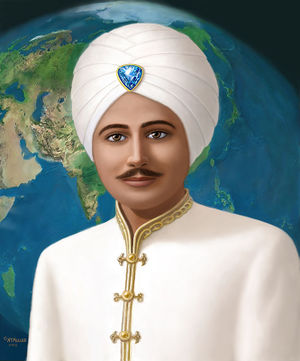चानंदा (Chananda)

चानंदा श्वेत महासंघ (Great White Brotherhood) की भारतीय महासभा (Indian Council) के प्रमुख हैं। उनकी बहन दिव्य महिला गुरु नाजाह (Najah) हैं।
अभिव्यक्ति (Embodiments)
चानंदा मु (लेमुरिया, महाद्वीप, जिसे मु के नाम से भी जाना जाता है) के विद्वान थे और सात पहाड़ियों के शहर में रहते थे जहां अब सैन फ्रांसिस्को (San Francisco) है।
'वह यीशु के समय भी देहधारी थे और यहूदिया में गुरु को जानते थे। उन्होंने उनके तेजोमय चुंबकत्व को देखा और "उनके बाहरी वस्त्र के माध्यम से अमरता की उपस्थिति को चमकते हुए देखा।"[1]
आज उनकी सेवा
कुछ अछूते चेलों को, चाणंद ने सभी अछूते यजमानों के लिए उपलब्ध असाधारण शक्तियों का प्रदर्शन किया है। एक अवसर पर, उन्होंने खुद को, गॉडफ्रे, रेक्स और नाडा, बॉब और पर्ल (तब अछूते) को एक “जादुई कालीन” (फ़ारसी गलीचे से ढकी धातु की एक शीट) पर ग्यारह हज़ार फ़ीट ऊपर वायुमंडल में एक घाटी के दृश्य का आनंद लेने के लिए उड़ाया।[2]
चन्नंदा 1937 में पृथ्वी की स्वतंत्रता के लिए अपनी योजना को लागू करने के लिए सेंट जर्मेन की सहायता करने के लिए आगे आए, जैसा कि उनकी बहन, आरोही महिला मास्टर नाजाह ने 1938 में किया था। वह दुनिया की सरकारों की सहायता करते हैं, जबकि वह युवाओं के साथ काम करती है, अक्सर भारत और चीन के कुछ हिस्सों में एक युवा लड़की के रूप में दिखाई देती है, लोगों को पढ़ाती है और उनकी मदद करती है।
चानंदा वर्तमान में दार्जिलिंग परिषद और ब्रदरहुड के अछूते दीक्षार्थियों के साथ एक शीर्ष प्राथमिकता वाली परियोजना पर काम कर रहे हैं। इस परियोजना का एक हिस्सा संयुक्त राज्य अमेरिका के संविधान के पीछे के सिद्धांतों पर आधारित स्वर्ण युग की सरकार की स्थापना करना है। यह ईश्वर-प्रेरित दस्तावेज़ अमेरिका को इसके संस्थापक, आरोही गुरु सेंट जर्मेन द्वारा जारी किया गया था; और जब इसका उचित उपयोग और पालन किया जाता है, तो यह एक स्वर्ण युग की सभ्यता की कुंजी प्रदान करेगा जो क्षितिज से परे है।
Chananda is particularly concerned with the problems of racial and religious divisions between people and with the future of India. He outlines the path of peace as the way of overcoming:
India was won through nonviolence. We shun violence and exude the peace of the Buddha, which is the all-power of God. But we would have our chelas understand that when you depend upon the peace of the Buddha as the ultimate power, then it would be well for you to study assiduously the terms of that peace. For you must make peace with your God if you expect your God to provide that power in the hour when peace is challenged by absolute war....
I know whereof I speak. I remember in a previous incarnation as the battle raged all around me and I stood holding the balance in the midst of thousands and ten thousand. Blessed hearts, I stood in their midst holding the focus of the sacred fire. And do you know—they saw me not! I was not visible in the physical spectrum, though I was in physical embodiment. And thereby … by my unswerving allegiance to the light, which I owe to the Almighty and to him alone—I was that pillar! I was that fire! And thus they could not continue the battle. And they retreated on both sides, leaving me standing alone in the midst of the plain of the battle itself.[3]
Call to beloved Chananda, the Great Divine Director, El Morya and Saint Germain for the proper implementation of the plans for God-government throughout the world.
Retreats
► Main article: Cave of Light
► Main article: Palace of Light
Chananda is hierarch of the Cave of Light, the focus of the Great Divine Director in India. The Palace of Light, which is adjacent to the Cave of Light, is the home of Chananda and Najah.
See also
Indian Council of the Great White Brotherhood
Sources
Mark L. Prophet and Elizabeth Clare Prophet, The Masters and Their Retreats, s.v. “Chananda.”
